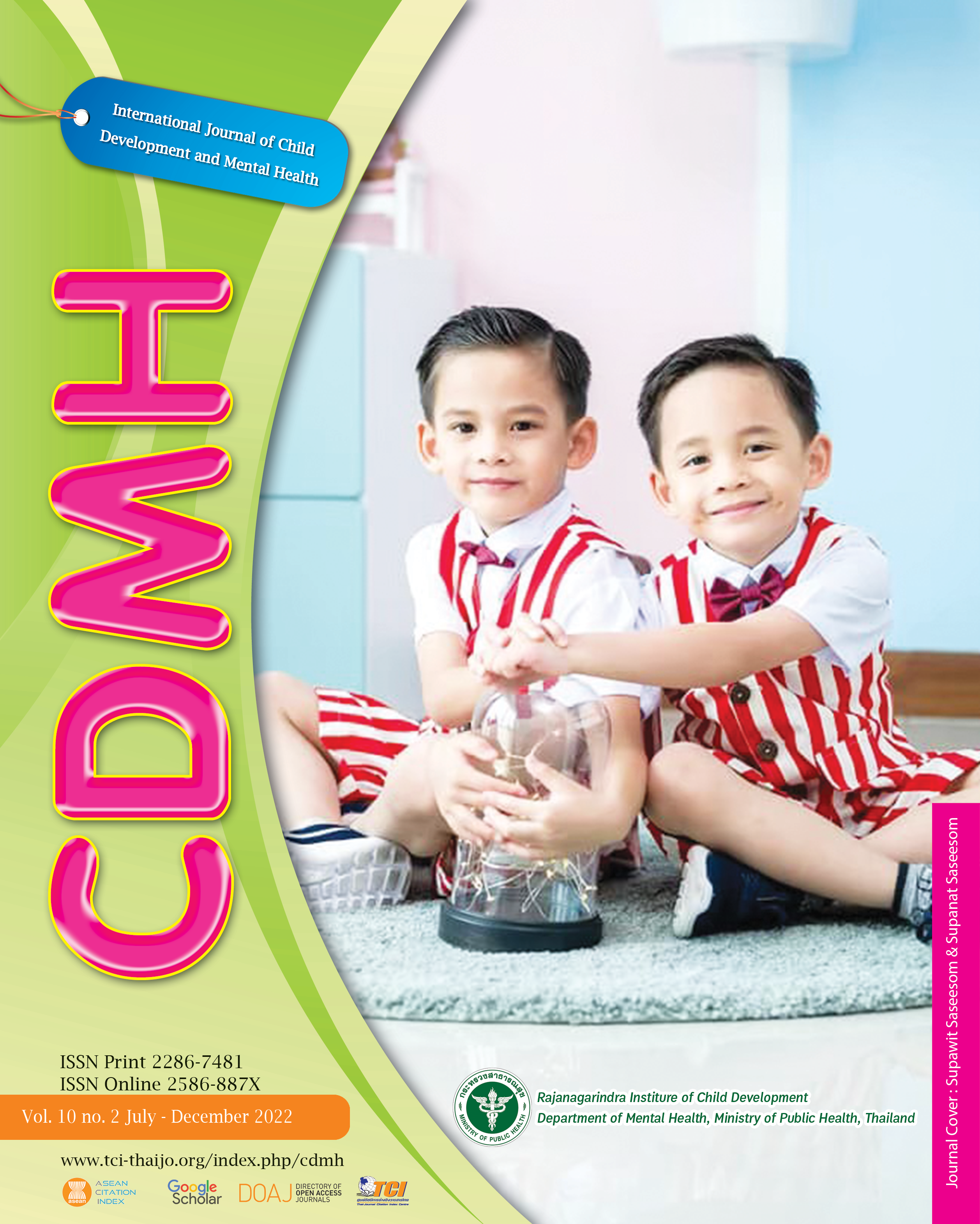Effects of the Language Development Program Based on Early Childhood Developmental Surveillance and Promotion
Main Article Content
Abstract
The research aimed to compare the child’s language development and the caregiver’s knowledge, attitude, and behavior before and after joining the Language Development Program Based on the Early Childhood Developmental Surveillance and Promotion Manual (DSPM). The study samples consisted of 12 caregivers and 12 children who visited the Well Baby Clinic, Medical Service Department, Sirindhorn Hospital, Bangkok, Thailand. The children were divided into two groups, 1) six 18-month-old children and 2) six 30-month-old children, that were recruited using a purposive sampling method. The instruments for collecting the data were1) a general information questionnaire, 2) Knowledge of Childhood Development Assessment Form, 3) Language Development Attitude Assessment Form, and 4) Language Development Behavior Assessment Form. The Wilcoxon matched pairs signed-ranks test statistics were used to compare the caregiver's knowledge, attitude, behavior, and child's language development before and after participation in the program. The results indicated that the language development of 18-month-old and 30-month-old children was greater than before the experiment (M.D.=3.0; SD=0 and M.D.=3.5.0; SD=0.84, respectively). After the caregivers had engaged in the program for three months, their attitudes and behavior showed statistically significant improvement (P<0.05). However, there was no statistically significant improvement in the caregivers’ knowledge after participating in the program.
Article Details

This work is licensed under a Creative Commons Attribution-NonCommercial-NoDerivatives 4.0 International License.
![]()
Creative Commons License
This work is licensed under a Creative Commons Attribution-NonCommercial-No Derivatives 4.0 International (CC BY-NC-ND 4.0)
The authors retain copyright and permit the journal the copyright of first publication
Articles, once having passed the review process and accepted for publication in the CDMH Journal, are copyrighted under the CDMH Journal, Department of Mental Health, Ministry of Public Health. Please be aware distribution of CDMH Journal content for commercial purposes without permission is expressly prohibited. However, distribution with intent to educate, advocate, or spread awareness within the general public and research communities is permitted and encouraged with the understanding that the CDMH Journal Editorial Board do not hold jurisdiction or liability for any accompanying comments, text, or information from third parties, either in favor for or against the original article’s assertions, conclusions, methodology, or content.
References
Busaban, W. (2021). The Effects of a Developmental Promotion Program with the Development Assessment and Promotion of Children at Risk (DAIM) and Learning Theories for Adults. (Master's Thesis, Mahidol University). (in Thai)
Casasola, M. (2011). Research Sheds Light on How Babies Learn and Develop Language the Department of Human Development, Cornell University. Retrieved 2018 October 23 from from: https://www.academia.edu/9182031/Research_Sheds_Light_on_HowBabies_Learn_and_Develop_Language
Chonchaiya, W. (2018). Children and Electronic Media : Effect on Development, Behavior and Health. In Sucharipong, S., Rungpraiwan, R., Hansakunachai, T., Benjasuwanthep, B., Fuengfoo, A., Juthaphisit, J., & Rojmahamontkol, P. (Eds.), A textbook on Development and Behavior in children (3 th. ed). (pp. 63-86). (in Thai)
Fuengfoo, A. (2013). Toys and play to promote development according to age. In Hansakunachai, T., Rungpraiwan, R., Teeranate, C., Fuengfoo, A., Sucharitpong, S., & Noipayak, P(Eds.) ร. Textbook of Child Development and Behavior for general practice (3nd). (pp.335-348).
Bangkok. (in Thai)
Juthaphakdikul, N. (2011). Chapter 9 Sensory Experience and Critical Peroid. Textbook of Neuroscience. Developmental Neurology. (pp.155-169). Mahidol University Salaya. Bangkok. (in Thai)
Kotchabhakdi, N. (2015). Brain and learning development. (Brain and Learning Development). research and development projects Salaya stem cells Neuroscience Research Center Biomolecular Research Institute Mahidol University, Salaya, Nakhon Pathom. (in Thai)
Kotchabhakdi, N. (2015). Development of the human brain. DSPM, DAIM workshops promoting the development of children from birth to 5 years of age, Health Center District 4, Ratchaburi 08/05/2015. (in Thai)
Kotchabhakdi, N. (2015). Brain and Learning Development. SALAYA STEM CELL R & D PROJECT. Research Center for Neuroscience , Institute of Moleicular Bioscience, Mahidol University, Salaya. (in Thai)
Kotchabhakdi, N. (2018). Brain and Child Development. Workshop on Using the Core Curriculum Using the Early Childhood Surveillance and Development Promotion Manual (DSPM) for Health Service Personnel on March 26-27, 2018 at the Miracle Grand Convention Hotel. Bangkok. (in Thai). Retrieved on June 25, 2019 from : http://bit.ly/2WOh8fu
National Statistical Office of Thailand (2018). The reading of population survey. (in Thai)
Nopmaneejumruslers, K. (2013). Quality of Thai Preschool Children. Quality of Children’ Life 2013. (pp.43-55). (in Thai)
Pattanapongthorn, J. (2017). The Study of Factors Affecting the Development of Thai Early Childhood 6th, 2017. Department of Health, Ministry of Public Health.(in Thai) Retrieved February 10,2020,
from:http://hp.anamai.moph.go.th/download/article/article_20190225123524.pdf
Pruksanonda, C. (2014). Practicing speaking with children. (in Thai)
from:คลินิกเด็ก.com, www. พัฒนาการ เด็ก.com/2013/01/talk-to-your-baby.html
Rogers, E. M. (1978). Traditional midwives as family planning communication in Asia. Honolulu: The East West Communication Institute. Retrieved January 4, 2017, from http://rh. anamai.moph.go.th/all_file/yfhs/YFHS%20
Ruangdaraganon, N. (2011). Deficiency in learning skills. In Hansakunachai, T., Rungpraiwan, R., Teeranate, C., Fuengfoo, A., Sucharitpong, S., & Noipayak, P. (Eds.), Child Development and Behavior Textbook for Medical Practice. general. (pp. 376–391). Bangkok. (in Thai)
Ruangdaraganon, N. (2011). Promoting language development through reading. In Hansakunachai, T., Rungpraiwan, R., Teeranate, C., Fuengfoo, A., Sucharitpong, S. & Noipayak, P. (Eds.), A textbook on child development and behavior for general practice (pp.79–91).
Bangkok. (in Thai)
Rungpraiwan, R. (2013). Promoting language skills for children. In Hansakunachai, T., Rungpraiwan, R., Teeranate, C., Fuengfoo, A., Sucharitpong, S. and Noipayak, P.(Eds.). A Textbook of Child Development and Behavior. for general practice (3rd.). (pp. 108-113). Bangkok. (in Thai)
Samawattana, K, Thienthong M, Methapat P, & Satiyakon P. (2011).
Development of parent training courses in organizing activities to enhance learning experiences of early childhood children. Maha Sarakham Rajabhat University Journal, 5(3). (in Thai)
Theeranate, C. (2011). The Effects of Media on Children and Adolescent Health. In Hansakunachai, T., Rungpraiwan, R., Teeranate, C, Fuengfoo, A., Sucharitpong, S. & Noipayak, P. (Eds.), A textbook on child development and behavior for general practice (pp. 268–283). Bangkok. (in Thai)
Yuwaphum, W. (2017). A study of the Holistic Approach to Child Development According to the DIR/Floortime Concept : Banlat Hospital, Phetchaburi. International journal of child development and mental health. Vol. 5 No 1 August – January 2017, (43-54). (in Thai)


